Now & New
- Experience
Hiroshima Sumiyoshisan: Summer Festivals Continue to Flourish
Just a little over a month prior, we had Toukasan, the first of the Three Great Festivals of Hiroshima, and the best time of year to don a yukata while basking in the festive mood on the streets downtown. Around mid-July, the second of the Great Festivals rears its head: Sumiyoshisan, a celebration with centuries of history centered around the Sumiyoshi Shrine, situated a little south of the city center. While it may not be as famous as its brethren Toukasan or Ebessan, Sumiyoshisan is still a fitting time to join in on the festivities in a yukata if visitors so desire, and the fireworks set off here cause enough of a commotion to attract the citizens downtown. Furthermore, as some may be aware, Miyajima used to have a gargantuan display of fireworks in mid-August up until 2019 before the COVID-19 pandemic struck, but due to logistics concerns, the City of Hatsukaichi has determined that there will be no more fireworks festival on Miyajima even after the pandemic subsides. Hiroshima City strives to deliver the most fantastic fireworks this time of year, and Sumiyoshisan is but one summer festival that puts on a show good enough to make up for the loss of Miyajima’s own spectacle.
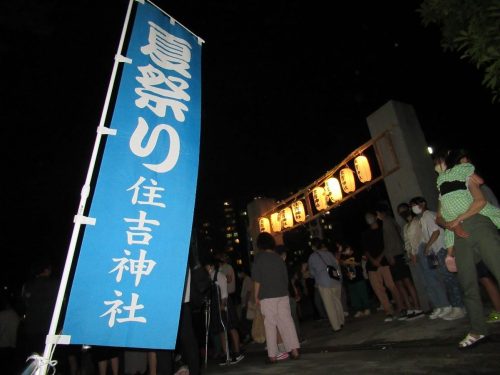
Although Sumiyoshisan is a core festival of the city, Sumiyoshi Shrine is located slightly out of the way, though not too much of a chore to access. Various bus lines from downtown (for instance, the #3 or the #6) will take you to 加古町 (かこまち – Kakomachi), the closest bus stop to the shrine, but walking there from Peace Memorial Park is also straightforward enough for tourists. First, from the Peace Memorial Museum, head west to the end just before the bridge (don’t cross it) and cross the street. From there simply, head south while hugging the east bank of the Ota River (the river around the Atomic Bomb Dome that doesn’t flow by the ruins) until you hit a park, then walk through it. It’s a lush, green space in the midst of a concrete jungle with some interesting décor, but you’ll see other festival goers on their way to Sumiyoshi Shrine too (look for little girls in summer kimono) so that’s how you know you’re on the right track.
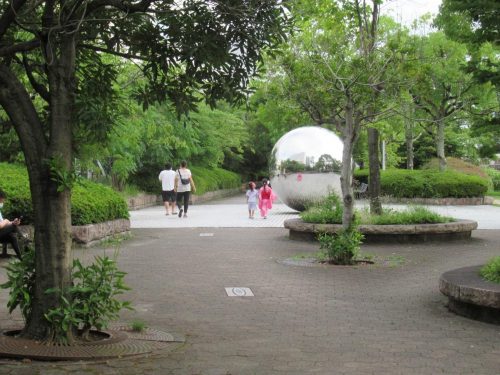
One thing I wish to point out is that from here on out, street crossings will not be right along the path you would be taking to the shrine, but please resist the temptation to jaywalk in a straight line! Not only is it illegal, but you would be dashing across buy roads where commuting automobiles are in a hurry getting on or off the highway, thus putting yourself in danger. Crosswalks on these streets are deliberately placed between street corners where it is safe for pedestrians to cross, so please take a quick detour to the left or right in order to cross properly, and then revert back to the road by the river. Feel free to use skybridges whenever you can, for they are legal, provide safety from cars, and afford optimal views of the setting sun and fireworks from a comparatively unperturbed location.
Ceremonial Boats
While approaching Sumiyoshi Shrine from the north, a joyous sight greeted by field of vision: off in the distance, on the river just before a red arched bridge, a traditional festival boat was being rowed by over a dozen men in happi (法被 – はっぴ), a traditional coat typically seen at Japanese festivals. Spectators were gazing upon the men in awe, and modern motorboats also whizzed by to ensure safety and probably take close-up pictures and videos of the event. I frantically took a detour onto the skybridge to cross the street and arrived at the Sumiyoshi Shrine grounds, from where I would have a better view of the action.
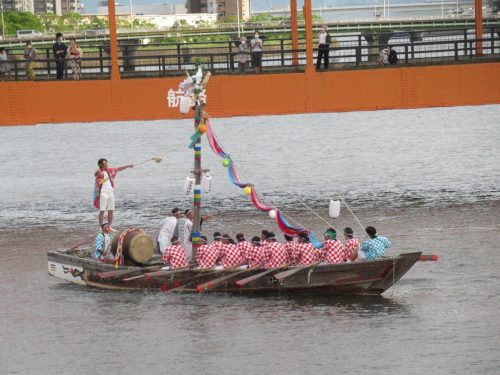
By the time I descended the stairs to the riverbank, there were two wooden boats traversing the river, and the second one had metal baskets holding flames. Slowly but surely, the two vessels approached each other and made contact. One man from the flaming boat performed some ritual on the man leading the other boat, after which point both boats would be traveling up the Ota River in unison. They would row all the way to the Atomic Bomb Dome, where the Ota and Motoyasu Rivers meet, make a U-turn, then eventually return to Sumiyoshi Shrine at night.
May the Wind Be in Your Sails
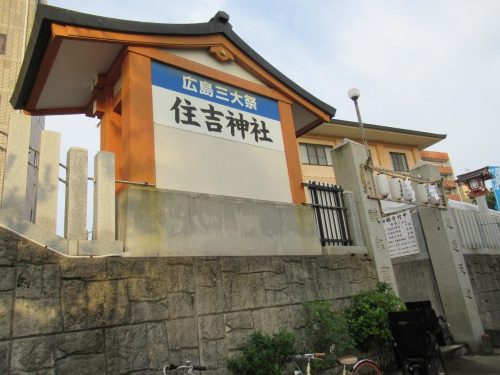
There are Sumiyoshi Shrines all over Japan, and most of them are located by the sea since the Sumiyoshi gods enshrined within traditionally watched over sailors, fishermen, and others who traveled by sea. Hiroshima’s Sumiyoshi Shrine was erected in 1733 in what was called 水主町 (かこまち – Kakomachi, not to be confused with the current Kakomachi), which has since been redubbed 中島町 (なかじまちょう – Nakajima-cho), the same neighborhood where today’s Atomic Bomb Dome is located. In 1798, sixty-five years after the shrine’s construction, a great fire broke out in that part of town, engulfing almost every edifice in the area. However, when the flames reached the then-Sumiyoshi Shrine, the fire was miraculously extinguished, which shocked the townsfolk speechless. Stopping the flames came at the cost of the shrine facilities aesthetics, which were tainted by the smoke, so Sumiyoshi Shrine was relocated to its current location and rebuilt the summer of the following year. The Sumiyoshisan festival that I attended commemorates the re-establishment of the shrine, and every summer, Hiroshimarians flock here to pray to the gods to keep them safe in their travels, regardless of vehicle.
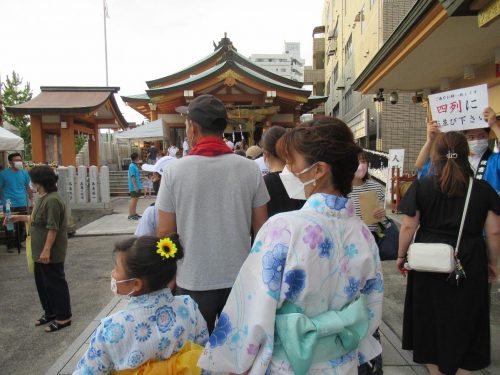
The west entrance to Sumiyoshi Shrine had a sign confirming that one of the Three Great Festivals of Hiroshima was indeed here. I went through the adjacent and shortly got into line to pray at the altar. Initially, I thought it was pretty long, but little did I know that it would get a lot more hectic as the night went on, so in retrospect, praying first thing upon arrival was the right thing to do. As I was waiting, I got my ¥5 coin ready, and when I got close to the altar, I noticed a cogon grass ring before me and a sign explaining the summer purification rites that occur this time of year. All worshippers should pass through the ring, circle back to the left to pass through a second time, circle back to the right to pass through a third time, and then circle back to the left again to pass through a final time and approach the altar to pray.
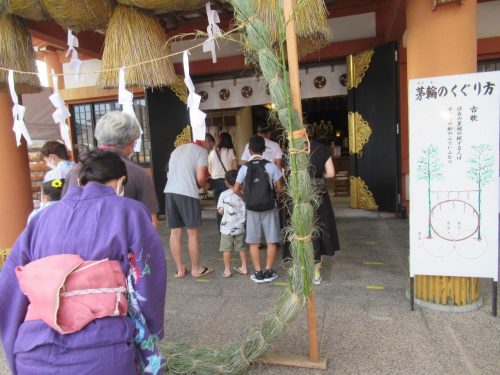
Festival Feels
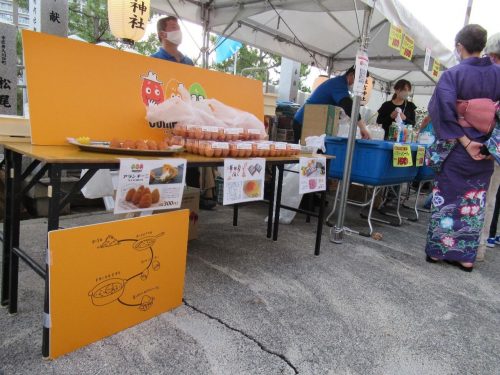
When I was done praying, I began to prowl the shrine grounds for a bite to eat, and I wasn’t expecting too much given how everyone was still in pandemic mode. Right next to where everyone was lining up to pray, there were only a few stalls selling ice cold beverages and arancini (Italian-style deep-fried rice balls). I would soon be proven wrong after walking out the front entrance to the shrine, past the kagura stage and down the stairs to a street packed with food vendors and carnival games. Looks like last month’s Toukasan got the ball rolling, and Sumiyoshisan has kept it rolling in this part of town!
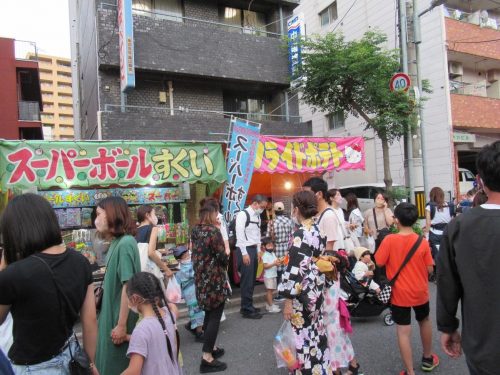
The huge variety in options had me indecisive for a good long while, but I eventually went for a fried cheese-and-hot-dog on a stick, which are all the rage in Japan nowadays thanks to the Korean wave. I took my mustard-covered delicacy back to the riverbank where I watched the boats to have my impromptu dinner. Compared to the chaos on the festival food street, it was much more peaceful here, with the only others being a couple of dining humans and the occasional river crab leaving and entering crevices in the rocky platform.
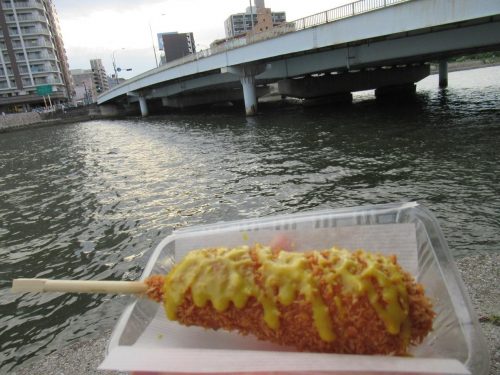
On my way back up to the shrine, I noticed that the kagura performance was starting and all seating space was taken, so I had to watch standing as close as I could. The four musicians who played accompanying tunes to the shows were phenomenal as usual, and everything from the costumes to the fight scenes were beautifully orchestrated, with the stage props and special effects enhancing what was already a stellar performance. Kagura shows tend to be based on old Japanese fables such as the story of Yamata no Orochi, an eight-headed serpent that was slain by the Shinto deity Susanoo (pronounced “sue-sah-no-oh”). I was accustomed to seeing men in oni outfits whenever I watched kagura, but seeing the coiling serpent heads that don’t even fit entirely on the stage sure took me by surprise.
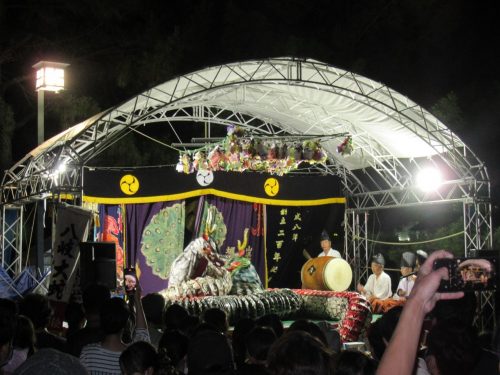
Standing while holding my camera above people’s heads did get tiring after a while, and I was also concerned about obstructing the view of spectators behind me so I tried not to raise my arms too high. On top of that, I also had a craving for more festival food, so I made sure to leave the kagura area between shows to check out what else was good to eat. For dessert, I bought myself a cup of sliced, frozen strawberries covered in chocolate sauce. Naturally, I would eat it back at the usual riverside spot, where the icy strawberry chips melted in my mouth like a healthy sorbet, bolstering my resistance to the hot, muggy summer air.
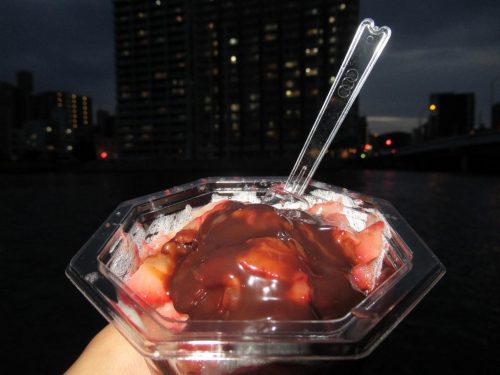
Moment of Joy: Interactive Theatrics
Your run-of-the-mill kagura performance will feature smoke to reveal the villain or streamers dropping from above to indicate some spell cast by a monster, both of which were in abundance that night. As expected, there were always reactions of bewilderment from the audience each time such a thing happened, especially coming from the kiddos. However, in one of the shows, an actor who portrayed a demon went the extra mile and actually went down to the audience to take a child hostage during the fight (the troupe asked for the parents’ permission in the moment and permission was granted). Of all the kagura I’ve watched at various festivals throughout Hiroshima Prefecture, that episode was a first for my eyes, and resulted in the most fun I have ever had watching kagura anywhere in Japan.
Stealth Fireworks
After that show was over, I went back down to browse the eats once again and hopefully take some more photos of life happening. I was just minding my own business, debating whether to eat something else or not, when out of the blue (or black?), I heard a boom from far away, and knew exactly what that meant. I hastily sought out a small grassy patch on the sidewalk by a takoyaki stand where I could patiently await the next explosion with minimal interference from passersby. Soon enough, a whistling sound was heard in the sky again, and after a couple attempts, I was able to capture the inconspicuous, infrequent fireworks.
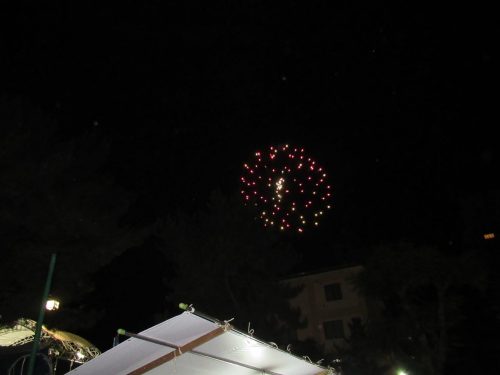
For better or worse, fireworks in Japanese festivals have been like this ever since 2020 (if they weren’t outright canceled), and usually, I had been in the wrong place at the right time. When advertising an event with fireworks, they would never announce anything but the existence of the fireworks in the vicinity, for revealing the time and place of the display would attract crowds and heighten the risk of spreading COVID-19. After my prayer, festival food dinner, and fair share of kagura entertainment, these small bursts in the sky checked off my last item on the “Summer Festival Checklist,” and I was ready to call it a night. On my way out, I took one last look at the kagura stage area and the queue of people looking to pray, both of which were more crowded than before.
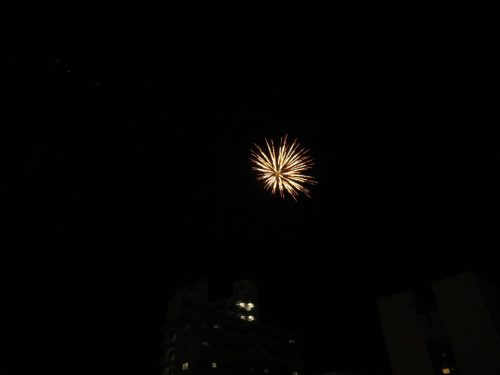
Even after I had left the shrine grounds and was on my way home, the stealth fireworks were still underway. I ascended the skybridge I had crossed earlier to reach the shrine in order to secure a vantage point, and though there were other groups with the same idea, the skybridge wasn’t crowded in the slightest with everyone else fixated on the stalls, kagura, and shrine. It also helped that there was little light pollution coming from the nearby buildings, which made for clearer photos of the explosions, and after a while, I was able to ascertain the origin point of the fireworks. As fate would have it, when I was walking back through the park from before, I found these two men by a pyrotechnic contraption, no doubt used to shoot the fireworks while I was at the festival.
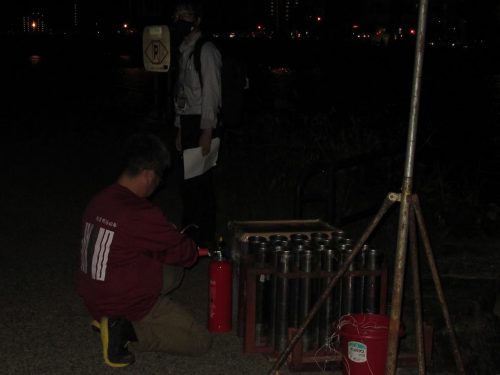
All in all, Sumiyoshisan is a rather small celebration, to the point where I have reservations of it being ranked among the Three Great Festivals of Hiroshima, but it encompasses all that a 夏祭 (なつまつり – summer festival) ought to be. The feeble fireworks from tonight were an exception on account of the pandemic, and I trust they’ll make a grandiose comeback as soon as next year. If Sumiyoshisan is indeed placed on the same pedestal as Toukasan and Ebessan, it is overdue a lot more promotion and recognition by the locals to make it deserving of its rank. Anyway, Sumiyoshisan has certainly earned its stripes in my book, and if a good number of foreign tourists discover this gem of a festival in our peaceful city, the festival will garner more media attention and finally be shown the respect it rightfully deserves.
Written by the Joy in Hiroshima Team
